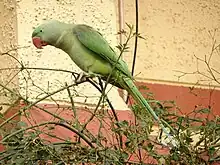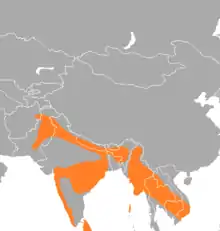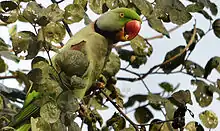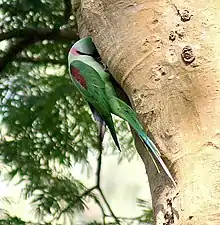Alexandrine parakeet
The Alexandrine parakeet (Psittacula eupatria), also known as the Alexandrine parrot, is a medium-sized parrot in the genus Psittacula of the family Psittaculidae, native to South Asia and Southeast Asia. It is named after Alexander the Great, who transported numerous birds from Punjab to various European and Mediterranean countries and regions, where they were prized by the royalty, nobility and warlords.[2][3]
| Alexandrine parakeet | |
|---|---|
_male.jpg.webp) | |
| Male P. e. eupatria Sri Lanka | |
 | |
| Female | |
| Scientific classification | |
| Domain: | Eukaryota |
| Kingdom: | Animalia |
| Phylum: | Chordata |
| Clade: | Dinosauria |
| Class: | Aves |
| Order: | Psittaciformes |
| Family: | Psittaculidae |
| Genus: | Psittacula |
| Species: | P. eupatria |
| Binomial name | |
| Psittacula eupatria (Linnaeus, 1766) | |
 | |
| Native range of Psittacula eupatria | |
| Synonyms | |
| |
The Alexandrine parakeet has established feral populations in Iraq, Kuwait, Saudi Arabia, Bahrain, Qatar, the United Arab Emirates and Iran, where it lives alongside feral populations of its close relative, the rose-ringed parakeet (Psittacula krameri).[1][2][4][5][6]
Taxonomy and etymology
The Alexandrine parakeet was first described by French zoologist Mathurin Jacques Brisson as Psittaca Ginginiana or "La Perruche de Gingi" (The Gingi's Parakeet) in 1760; after the town of Gingee in southeastern India, which was a French outpost then. The birds may, however, merely have been held in captivity there.[7] Carl Linnaeus redescribed the Alexandrine parakeet in 1766 as Psittacus eupatria.[8]

The genus name Psittacula is a diminutive of the Latin word psittacus meaning "parrot", and the specific name eupatria is derived from the Ancient Greek words eu- meaning "well" and patriá meaning "descent".[9][10][11]
In 2019, a genetic study revived the genus Palaeornis, formerly viewed as a synonym of the current genus Psittacula. Some organisations, including the IUCN, have accepted the new taxonomy. [12] If this were to be taken into account, this could mean that the Alexandine parakeet is the only living member of the now-revived genus.
Phylogeny
Genetic analysis of the mitochondrial cytochrome b sequences of Psittacula parakeets has shown that the Alexandrine parakeet diverged from the lineage that gave rise to the rose-ringed parakeet (Psittacula krameri) and the Mauritius parakeet (Psittacula eques) about 5 million years ago.[13]
Description
_pair_-2pc.jpg.webp)
The Alexandrine parakeet is one of the largest parakeets, measuring 56 to 62 cm (22 to 24 in) from the top of the head to the tip of the tail and weighing 200 to 300 g (7.1 to 10.6 oz). The tail measures 28 to 35 cm (11 to 14 in).[2][14] It is predominantly green with a light blue-grey sheen on the cheeks and nape (back of the neck), yellow-green abdomen, red patch on the shoulders and massive red beak with yellow tips. The upper-side of the tail passes from green at the top to blue further down, and is yellow at the tip. The underside of the tail is yellow.[2][14][15]
Adults are sexually dimorphic. Adult males have a black stripe across their lower cheeks and a pink band on their nape. Adult females lack both a black cheek stripe and a pink nape band. The young are similar in appearance to adult females but have shorter tails.[2][16]
Subspecies
Five subspecies of the Alexandrine parakeet are currently recognized[2][16]
| Subspecies | Distribution | Notes |
|---|---|---|
| Nominate Alexandrine parakeet (P. e. eupatria) | Western India, South India and Sri Lanka. | Nominate subspecies |
| Large Indian parakeet (P. e. nipalensis) | Eastern Afghanistan, Pakistan, North India, Central India, East India, Nepal and Bhutan. | It is larger than the nominate subspecies and more greyish-green. The back of the head and cheeks are washed with blue. Adult males have a broader black stripe across the lower cheek. |
| Large Burmese parakeet (P. e. avensis) | Northeast India, Bangladesh and Myanmar. | It has a smaller beak than the nominate subspecies. Males look like P. e. nipalensis, however the neck and underparts are more yellowish and there is a narrow blue stripe on the hindneck. |
| Large Andaman parakeet (P. e. magnirostris) | Andaman Islands and Coco Islands. | It is slightly larger than the nominate subspecies, and has a larger beak and brighter shoulder patch. Males have a narrow blue stripe above the nape band. |
| Thai rose-ringed parakeet (P. e. siamensis) | Vietnam, Cambodia, Laos and Thailand. | It is smaller than the nominate subspecies and has a paler shoulder patch. It also has a yellowish face and neck. Males look like P. e. avensis, however the back of the head and nape are washed with blue. |

Ecology and behaviour
The Alexandrine parakeet lives in forests, woodlands, agricultural lands and mangrove forests at elevations of up to 900 m (3,000 ft). It eats a variety of wild and cultivated seeds, buds, fruits and nuts. Flocks can cause extensive damage to ripening fruits and grain crops like maize and jowar. It usually lives in small flocks, but forms larger groups in areas where food is abundant or at communal roosts.[2][15]

The Alexandrine parakeet has a variety of calls, including a ringing trrrieuw, loud kree-aar or keeak, deep klak-klak-klak-klak and resonant gr-aak. Its calls are usually deeper, harsher and more resonant than those of the rose-ringed parakeet. Its voice becomes harsher when alarmed, and it shrieks loudly when mobbing predators. Flocks occasionally excitedly vocalize together. It is known to imitate human speech in captivity.[2][15][16][17]
Breeding

Alexandrine parakeets breed from November to April in their native range. They usually nest in tree hollows, but sometimes use tree holes excavated by themselves or cracks in buildings. Females lay 2 to 4 white, blunt oval-shaped eggs, measuring 27 to 34 mm (1.1 to 1.3 in). The average incubation period is 24 days. The chicks fledge at about 7 weeks of age, and are dependent on their parents until 3 to 4 months of age.[2][15]
Aviculture
Alexandrine parakeets are relatively popular pet birds due to their long lifespan in captivity (25–30 years),[18] playful behaviour and ability to mimic human speech. Alexander the Great is thought to have kept one as a pet. They are one of the most sought-after cage birds in the Indian market. According to CITES trade data, at least 57,772 Alexandrine parakeets were imported into countries outside their native range between 1981 and 2014.[1][3][4][19]
Color variants including lutino, albino, and blue are well-established in captivity.
The World Parrot Trust recommends that captive Alexandrine parrots be kept in a metal or welded mesh enclosure of minimum length 4.5 metres (15 ft).[18]
Conservation
The Alexandrine parakeet is listed as near threatened by the International Union for Conservation of Nature (IUCN) because of its steep population decline in its native range due to habitat loss, persecution and excessive capture to cater to the demands of the illegal wildlife trade. It is sporadic in South India, uncommon in Bangladesh, and declining in North Bengal and certain parts of Sri Lanka. It has suffered the greatest population declines in the Sindh and Punjab provinces of Pakistan, Laos, northwestern and southwestern Cambodia, and Thailand.[1][20][21]
The sale of Alexandrine parakeets is not banned in Pakistan, and they can be found being openly sold in the markets of Lahore and Rawalpindi. Their sale is banned in India, and yet they are sold in broad daylight in urban bird markets, suggesting that the Indian government is allocating insufficient resources for their protection.[19][21]
Culture
Sri Lanka, Vietnam, Thailand, Mongolia and Iran have issued postage stamps depicting the Alexandrine parakeet.[22][23][24][25]
References
- BirdLife International (2017). "Palaeornis eupatria". IUCN Red List of Threatened Species. 2017: e.T22685434A110985466. doi:10.2305/IUCN.UK.2017-1.RLTS.T22685434A110985466.en. Retrieved 18 June 2018.
- del Hoyo, Josep; Nigel J., Collar; David A., Christie; Andrew, Elliot; Lincoln D.C., Fishpool (2014). HBW and BirdLife International Illustrated Checklist of the Birds of the World. Vol. 1: Non-passerines. Barcelona: Lynx Edicions. ISBN 978-8496553941.
- Campbell-Johnston, Rachel (13 February 2007). "A squawk on the wild side". The Times. Retrieved 16 January 2013.
- Ancillotto, Leonardo; Strubbe, Diederik; Menchetti, Mattia; Mori, Emiliano (27 November 2015). "An overlooked invader? Ecological niche, invasion success and range dynamics of the Alexandrine parakeet in the invaded range" (PDF). Biological Invasions. 18 (2): 583–595. doi:10.1007/s10530-015-1032-y. hdl:10067/1292210151162165141. ISSN 1387-3547. S2CID 17533751. Archived from the original (PDF) on 25 September 2019. Retrieved 25 September 2019.
- Coughlan, Sean (6 July 2004). "Wild parrots settle in suburbs". BBC News. Retrieved 16 February 2018.
- BirdLife International (2018). "Alexandrinus krameri". IUCN Red List of Threatened Species. 2018: e.T22685441A132057695. doi:10.2305/IUCN.UK.2018-2.RLTS.T22685441A132057695.en. Retrieved 12 November 2021.
- Brisson, Mathurin Jacques (1760). Ornithologia, sive Synopsis methodica sistens avium divisionem in ordines, sectiones, genera, species, ipsarumque varietates (in Latin). Vol. 4. Paris, Leiden: Bauche. p. 343.
- Linnaeus, Carl (1766). Systema Naturae per Regna Tria Naturae, Secundum Classes, Ordines, Genera, Species, cum Characteribus, Differentiis, Synonymis, Locis (in Latin). Vol. I (12th ed.). Holmiae: (Laurentii Salvii). p. 140.
- Gill, Frank; Wright, Minturn (2006). Birds of the World: Recommended English Names. Princeton: Princeton University Press. ISBN 978-0691128276.
- Liddell, Henry George; Scott, Robert (1940). "εὖ". A Greek–English Lexicon (Ninth ed.). Oxford: Clarendon Press.
- Liddell, Henry George; Scott, Robert (1940). "πατριά". A Greek–English Lexicon (Ninth ed.). Oxford: Clarendon Press.
- "bee".
- Groombridge, Jim J.; Jones, Carl G.; Nichols, Richard A.; Carlton, Mark; Bruford, Michael W. (April 2004). "Molecular phylogeny and morphological change in the Psittacula parakeets". Molecular Phylogenetics and Evolution. 31 (1): 96–108. doi:10.1016/j.ympev.2003.07.008. ISSN 1055-7903. PMID 15019611.
- Blanford, William Thomas (1895). The Fauna of British India, Including Ceylon and Burma. Birds. Vol. 3. London: Taylor and Francis.
- Ali, Salim (2003) [1941]. The Book of Indian Birds (13 ed.). Oxford University Press. ISBN 978-0195665239.
- Forshaw, Joseph M.; Knight, Frank (2010). Parrots of the World. Princeton, NJ: Princeton University Press. ISBN 978-0643100572.
- Juniper, Tony; Parr, Mike (1998). Parrots: A Guide to the Parrots of the World. New Haven, CT: Yale University Press. ISBN 978-0300074536.
- "Alexandrine Parakeet (Psittacula eupatria) Parrot Encyclopedia". World Parrot Trust. Retrieved 14 March 2021.
- "TRAFFIC helps to claw back illegal parrot trade in India". World Wide Fund for Nature. 15 February 2012. Archived from the original on 2018-11-04. Retrieved 4 November 2018.
- Red List of Bangladesh Volume 3: Birds (PDF). 2015. p. 375. ISBN 9789843407368. Retrieved 18 June 2018.
{{cite book}}:|work=ignored (help) - Ilyas, Faizawork (10 March 2013). "Parrots population declining fast in Sindh and Punjab: survey". Dawn. Archived from the original on 20 February 2018. Retrieved 18 February 2018.
- "Alexandrine Parakeet at Bird-Stamps". Retrieved 12 April 2020.
- "Birds on Stamps: Thailand". Retrieved 24 October 2013.
- "Birds on Stamps: Mongolia". Retrieved 24 October 2013.
- "Birds on Stamps: Iran". Retrieved 24 October 2013.
Further reading
- Alexandrine Parakeet (Psittacula eupatria) | Parrot Encyclopedia by the World Parrot Trust
- Birds of the Indian Subcontinent by Richard Grimmett, Carol Inskipp and Tim Inskipp, ISBN 1408127636
External links
- Wildscreen Arkive: Alexandrine parakeet (Psittacula eupatria) Gallery and fact sheet
- Oriental Bird Images: Alexandrine parakeet Selected images

.jpg.webp)